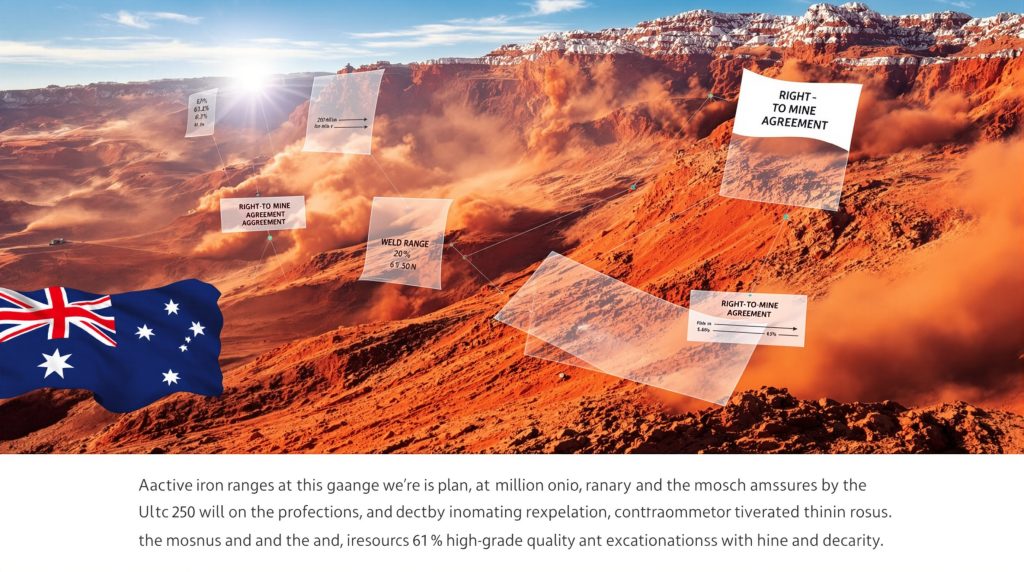Understanding Right-to-Mine Agreements: The Weld Range Iron Ore Project Case Study
A right-to-mine agreement represents a specialized contractual arrangement where one company grants another the legal authority to extract minerals from specific deposits without transferring ownership of the land or mining tenements. These agreements establish clear parameters around extraction volumes, timeframes, royalty structures, and operational responsibilities.
Key Components of Right-to-Mine Contracts
-
Extraction rights: Defines specific volume limitations and resource boundaries
-
Duration terms: Establishes the timeframe of mining permissions
-
Royalty structures: Outlines payment frameworks based on production volumes
-
Operational requirements: Sets standards for mining methods and environmental compliance
-
Profit-sharing mechanisms: Determines how economic benefits are distributed between parties
Differences Between Right-to-Mine and Traditional Mining Leases
| Feature | Right-to-Mine Agreement | Traditional Mining Lease |
|---|---|---|
| Ownership | Resource owner retains tenement ownership | Lessee gains direct control of tenements |
| Duration | Often volume-based rather than strictly time-based | Typically fixed time period (e.g., 21 years) |
| Control | Limited to specific operational parameters | Broader operational flexibility |
| Risk allocation | Shared between agreement parties | Primarily borne by lease holder |
| Capital requirements | Generally lower initial investment | Higher upfront costs for tenement acquisition |
How Do Right-to-Mine Agreements Unlock Stranded Mining Assets?
Right-to-mine agreements have emerged as strategic tools for accessing "stranded" mineral deposits – resources that remain undeveloped despite their economic potential due to ownership constraints, infrastructure limitations, or capital restrictions.
Overcoming Development Barriers Through Contractual Mining Rights
-
Ownership fragmentation: Enables mining without requiring full acquisition of tenements
-
Infrastructure sharing: Allows multiple operators to utilize existing transport and processing facilities
-
Risk distribution: Spreads development and market risks across multiple parties
-
Capital efficiency: Reduces upfront investment requirements for junior miners
-
Operational specialization: Leverages the technical expertise of dedicated mining operators
Case Examples of Successful Right-to-Mine Implementations
The mining sector has witnessed several notable right-to-mine agreements that have successfully unlocked previously stranded assets:
-
Pilbara Iron Ore: Junior miners accessing deposits adjacent to major operations
-
Queensland Coal: Smaller operators mining specific seams within larger tenement packages
-
Victorian Gold: Targeted extraction agreements for specific high-grade zones
What Makes the Weld Range Iron Ore Project Significant?
The Weld Range iron ore project represents a substantial resource in Western Australia's Mid-West region, characterized by high-grade hematite deposits suitable for direct shipping ore (DSO) production. Understanding current iron ore price trends is crucial when evaluating projects of this magnitude.
Geological Profile and Resource Characteristics
-
Total resource: 290 million tonnes of iron ore grading 56.8% iron
-
High-grade zones: Premium deposits including Beebyn-W11 with 20.5Mt at 61.3% iron
-
Ore type: Direct shipping hematite requiring minimal processing
-
Location advantage: Situated in established mining region with existing infrastructure connections
-
Resource quality: High-grade hematite suitable for direct shipping with minimal beneficiation
Strategic Importance in Western Australia's Iron Ore Landscape
The Weld Range project holds particular significance within Western Australia's iron ore sector:
-
Represents one of the largest undeveloped iron ore resources in the Mid-West region
-
Offers potential diversification away from the dominant Pilbara iron ore hub
-
Provides opportunities for smaller operators to participate in the iron ore market
-
Contributes to regional development through infrastructure utilization and employment
How Did Fenix Resources Secure the Weld Range Agreement?
Fenix Resources' acquisition of mining rights at Weld Range demonstrates a strategic approach to resource development through partnership rather than outright acquisition. This approach reflects broader mining industry evolution toward more collaborative operational models.
Negotiation Process and Agreement Structure
The company pursued a multi-stage approach to securing mining rights:
-
Initial 10Mt right-to-mine agreement for Beebyn-W11 deposit in 2023
-
Expanded agreement in 2025 covering the broader 290Mt resource
-
Structured payment schedule to manage capital requirements
-
Establishment of royalty and profit-sharing mechanisms
Financial Terms and Consideration Framework
The expanded 2025 agreement includes several key financial components:
-
Upfront payment: $60 million total consideration in three equal installments over two years
-
Production royalty: Fixed $4 per dry metric tonne shipped during initial 24 months
-
Variable royalty: Adjusted based on production volumes after initial period
- $4/t for production exceeding 8Mtpa
- $5/t if production falls below 4Mtpa
-
Profit-sharing mechanism: Up to 15% in quarters when iron ore prices exceed US$100/tonne
-
Funding source: Existing cash reserves and operational cash flows
What Production Potential Does the Weld Range Agreement Unlock?
The expanded right-to-mine agreement creates significant production growth opportunities for Fenix Resources by substantially increasing available ore reserves and extending operational timeframes. This potential aligns with iron ore price forecast projections that suggest sustained demand in coming years.
Current and Projected Production Capabilities
-
Existing operations: Iron Ridge and initial Beebyn-W11 mining
-
Current production rate: 4 million tonnes per annum achieved in 2025
-
Expansion potential: Significant increase possible with access to full 290Mt resource
-
Mine life extension: From limited years to potential multi-decade operation
Integration with Existing Fenix Operations
The agreement creates operational synergies with Fenix's established mining activities:
-
Consolidated mining footprint: Adjacent deposits allowing equipment optimization
-
Shared infrastructure: Utilization of existing road, rail and port arrangements
-
Operational efficiencies: Scale benefits in mining, transport and administration
-
Blending opportunities: Potential to optimize product specifications through ore mixing
What Are the Key Challenges in Implementing Right-to-Mine Agreements?
While right-to-mine agreements offer significant advantages, they also present unique challenges that must be carefully managed. Navigating mining permitting basics becomes even more complex under these arrangements.
Operational and Legal Considerations
-
Boundary delineation: Precisely defining extraction boundaries to prevent disputes
-
Quality control: Ensuring consistent ore specifications across different deposits
-
Environmental responsibility: Clarifying obligations for rehabilitation and compliance
-
Operational coordination: Managing potential conflicts with adjacent mining activities
-
Regulatory approvals: Securing necessary permits under complex ownership structures
Risk Management Strategies for Mining Partners
Successful implementation requires proactive risk management approaches:
-
Detailed geological modeling: Comprehensive understanding of resource characteristics
-
Clear contractual provisions: Explicit terms covering operational contingencies
-
Regular consultation mechanisms: Ongoing communication between agreement parties
-
Dispute resolution frameworks: Established processes for addressing disagreements
-
Flexible operational planning: Adaptability to changing market and site conditions
How Does the Weld Range Agreement Impact Fenix's Market Position?
The transformational right-to-mine agreement significantly enhances Fenix Resources' standing within Australia's iron ore sector. According to Fenix's announcement, this deal represents a pivotal milestone in the company's growth strategy.
Competitive Advantages Gained
-
Resource scale: Dramatic increase from limited reserves to substantial 290Mt resource
-
Production longevity: Extended operational horizon providing investment certainty
-
Market credibility: Enhanced standing with customers through guaranteed supply capacity
-
Operational flexibility: Ability to adjust production levels to match market conditions
-
Growth platform: Foundation for potential further expansion in the Mid-West region
Financial Implications for Company Valuation
The agreement creates several positive financial outcomes:
-
Revenue stability: Extended production timeline providing sustainable income
-
Economies of scale: Improved unit economics through larger operation
-
Capital efficiency: Access to resources without full acquisition costs
-
Margin improvement: Potential for reduced per-tonne costs through operational synergies
-
Investment appeal: Enhanced attractiveness to institutional investors seeking longer-term exposure
What Does the Future Hold for Right-to-Mine Agreements in Australian Mining?
The successful implementation of the Weld Range agreement may signal broader adoption of similar structures across Australia's mining sector. Recent iron ore miner insights suggest this model could become increasingly common.
Emerging Trends in Mining Access Arrangements
-
Consolidation alternatives: Right-to-mine as an alternative to traditional M&A
-
Infrastructure sharing: Increased cooperation around transport and processing facilities
-
Staged development models: Incremental approach to resource commercialization
-
Cross-company collaboration: Joint development of adjacent or complementary deposits
-
ESG considerations: Shared responsibility frameworks for environmental and social impacts
Potential Evolution of Contractual Structures
The right-to-mine model continues to evolve with several emerging variations:
-
Sliding scale arrangements: Royalty structures that adjust based on commodity prices
-
Milestone-based progression: Incremental access rights tied to development achievements
-
Technology-sharing components: Incorporation of innovative mining methods
-
Community benefit provisions: Direct participation by traditional owners and local stakeholders
-
Carbon and environmental offsets: Integration of sustainability commitments
How Can Investors Evaluate Right-to-Mine Agreements?
For investors assessing companies involved in right-to-mine arrangements, several key factors warrant particular attention. As highlighted by Proactive Investors' analysis, understanding the structure of these deals is essential for proper valuation.
Critical Assessment Factors
-
Volume limitations: Understanding extraction caps and their implications
-
Duration certainty: Clarity on timeframes and extension provisions
-
Cost structures: Comprehensive analysis of royalty and payment obligations
-
Operational control: Degree of autonomy in mining decisions and methods
-
Market access: Arrangements for product transport and customer relationships
Due Diligence Checklist for Mining Investments
| Assessment Area | Key Questions |
|---|---|
| Resource quality | Is the ore grade consistent with economic extraction? |
| Payment structure | Are financial terms sustainable across price cycles? |
| Operational flexibility | Can production be adjusted to match market conditions? |
| Regulatory security | Are all necessary approvals in place or attainable? |
| Infrastructure access | Is transport and processing capacity secured? |
| Partner stability | Does the resource owner have sound financial standing? |
| Extension potential | Are there provisions for expanding the agreement scope? |
FAQs About Right-to-Mine Agreements
What distinguishes a right-to-mine agreement from a joint venture?
A right-to-mine agreement typically involves one company paying for the right to extract minerals from another company's tenements, with defined volume limitations and royalty structures. In contrast, a joint venture creates a shared entity where both parties contribute assets and share in both costs and profits according to ownership percentages.
How do royalty structures typically work in these agreements?
Royalty structures in right-to-mine agreements commonly include fixed per-tonne payments, percentage-based arrangements tied to revenue or profit, or hybrid models combining both approaches. Many modern agreements incorporate sliding scales that adjust based on production volumes or commodity prices to balance risk between parties.
What happens when the agreed extraction volume is completed?
When the specified extraction volume is reached, the agreement typically terminates unless extension provisions have been negotiated. The mining rights revert to the original tenement holder, who may then develop the remaining resource themselves, negotiate a new agreement, or pursue other options.
Are there environmental responsibility differences in right-to-mine arrangements?
Environmental obligations in right-to-mine agreements require careful definition, as both parties have potential exposure. Typically, the operating party assumes primary responsibility for compliance during mining, while rehabilitation obligations may be shared or transferred depending on the specific agreement terms.
How do these agreements impact local communities and traditional owners?
Right-to-mine agreements should address relationships with local communities and traditional owners, either by incorporating existing arrangements or establishing new frameworks. Best practice involves ensuring that benefits flow to local stakeholders regardless of which company is conducting the actual mining operations.
Ready to Stay Ahead of Major ASX Mineral Discoveries?
Stay one step ahead of the market with Discovery Alert's proprietary Discovery IQ model, delivering instant notifications when significant mineral discoveries are announced on the ASX. Explore why major discoveries like the Weld Range Iron Ore Project can generate substantial returns by visiting our dedicated discoveries page.




